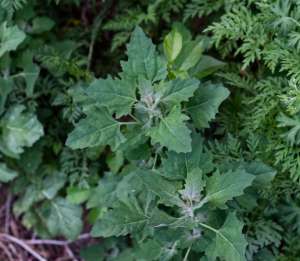Lambsquarters (Chenopodium album) is one of the better wild edible greens in my opinion.
It also goes by the names wild spinach, White goosefoot, fat hen, and pigweed, but it's not the same pigweed we otherwise know as amaranth.
Amaranth's genus is Amaranthus, although both lambsquarters and amaranth are in the same family, Amaranthaceae, so you could say they're cousins.
It's also closely related to quinoa (Chenopodium quinoa).
Lambsquarters is yet another non-native plant that was intentionally introduced as a food crop by European settlers.
Long forgotten as a mainstream food source nowadays, it regularly shows up uninvited in gardens throughout the United States.
While that may qualify it as a weed, it's really not a bad thing to find growing in your garden.

And although it's become somewhat cliche to call a wild edible weed a "spinach substitute," I'm going to do it.
Lambsquarters is a spinach substitute.
But really, it's better than spinach. I personally prefer its mild flavor and texture.
According to the USDA's FoodData Central database, compared with spinach, lambsquarters has three times more calcium, more Vitamin A and more Vitamin C.
It also doesn't have the same mouth-and-teeth-drying quality that spinach has, even though it is mildly astringent.
What sets it apart from a lot of other greens is the fact that it remains mildly flavored throughout its lifecycle, whereas most greens get more bitter as they mature.
Identification
Seedlings start popping up in spring/early summer and can eventually grow up to three feet high.
The delicate leaves have no midvein and are arranged alternately on the stem.
They have three distinguishing characteristics:
1) The larger, lower leaves are somewhat diamond-, arrowhead- or triangle-shaped with deeply toothed or wavy edges, while the smaller, upper leaves have smoother edges.
2) They produce a mealy, waxy, fine white powder that covers the plant and tends to coat the upper-most newest leaves on the stalk, as well as the undersides of leaves, giving them a talcum powder-like appearance.
3) The tops of the leaves are smooth and blue-green, while the undersides are whitish-gray.
They're also really tender and wilt quickly after picking.
Lambsquarters' small green flowers may appear throughout summer in tiny clusters growing on a branched stem.
Habitat
Like most non-native weeds, lambsquarters thrives in disturbed areas -- gardens, yards, roadsides, fields, etc.
You won't find it in more balanced, established ecosystems that comprise mostly native plants.
It loves areas that have been heavily fertilized like agrigultural fields and surrounding land -- avoid picking it from those areas.
Like amaranth, lambsquarters has a tendency to absorb nitrates (not something you want to eat), and synthetic fertilizer leaves high concentrations of nitrates in the soil.
Lambsquarters has also been studied as a potential candidate for bioremediation due to its tendency to absorb heavy metals.
Pesticides are full of heavy metals, so plants gathered from sprayed fields would likely also be contaminated with heavy metals, among other pollutants.
Edible use
Eating the leaves
Be aware that lambsquarter leaves are high in oxalic acid, which is a concern for anyone who should limit oxalates or wants to avoid them.
They can be eaten raw or cooked but cooking reduces the oxalate content somewhat.
Cooking won't get rid of heavy metals, nitrates or other toxins, though, so I'll reiterate the importance of harvesting where the soil hasn't been contaminated by fertilizer and pesticide.
Since the leaves are so tender and don't keep long, they're best picked right before you plan to eat them.
And if you're going to eat them raw, you may want to rinse off the mealy coating from the leaves first.
The mealy powder is perfectly edible, but it gives the leaves a less-than-desirable grittiness.
If you plan to cook them, be sure to gather more than you think you'll need since they're really prone to cooking down to nothing and turning to mush.
The best method of cooking is to lightly steam or sautee to avoid overcooking.
You can also dry the leaves and use them later in soups and stews.